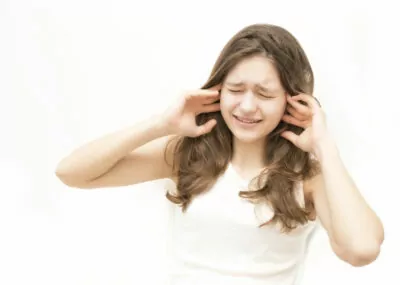
According to Merriam-Webster, Hyperacuity is “greater than normal acuteness of a sense, including hearing. Hyperacusis is defined by the Cleveland Clinic as “a rare hearing disorder where sound others perceive as normal, seem uncomfortable and often unbearably loud. It is also described as decreased sound tolerance or DST.”
Many vestibular patients experience hyperacusis, and it can quickly become the most debilitating symptom for them as they continue their daily lives. Imagine no longer being able to tolerate your young daughter’s noises that she makes when playing, like VeDA Ambassador, Heather Davies. Or having to switch seats at a restaurant because it’s too loud to even read the menu, like this author has had to do. This is only a snapshot of what it can be like for patients with hyperacusis.
However, as with every hurdle in the road of being a vestibular patient, there are always some tricks and tips from fellow patients and healthcare professionals to make life more easily lived and activities of daily living (ADLs) possible.
According to Dr. Eric Botswisk, an audiologist and Clinical Coordinator with St Luke’s University Health Network, the recommended journey for those with suspected hyperacusis should include seeing an ENT and an audiologist to schedule a hearing test.
Once a hyperacusis diagnosis is made, Dr. Botswick recommends Graduated Exposure Therapy to lessen sound sensitivity, as well as Cognitive Behavioral Therapy (CBT) for sound desensitization. He also recommends white noise as a way to desensitize yourself to sounds, which can easily be found on many music platforms, relaxation apps, or online.
What can become harmful when experiencing hyperacusis is sound avoidance and the over use of ear plugs. While ear plugs or ear muffs can help decrease bothersome levels of sound, using them all the time will “reinforce the brain’s avoidance of sound and cause a snowball effect,” according to Dr. Botswick. It is more effective to graduate through different sounds and understand that tolerance levels will build if the patient is not avoiding the sound stimuli. This process is called habituation.
Dr. Bostwick’s tips and tricks:
- Ear plugs are great for HARMFUL levels of sound, but not as an everyday practice to avoid noise.
- Have a hearing test done to rule out other issues related to hyperacusis.
- Use white noise to help build tolerance to sounds that are bothersome.
- Try graduated exposure therapy and CBT to help you cope with sound sensitivity.
As many vestibular patients are aware, every person’s symptomology and ways to cope are different. Heather Davies, a VeDA Ambassador, was a part of a hyperacusis study at the University of South Florida in 2020, which allowed her to identify the most triggering sounds and modify her lifestyle to such.
Heather’s tips and tricks:
- Find ear plugs or get custom masking hearing aids in the early stages of hyperacusis.
- Make lifestyle adjustments, such as using paper plates and plastic silverware if the noise of traditional tableware and cutlery are bothersome.
- Learn to expose yourself to bothersome sounds over time.
- Find a therapist and audiologist that specialize in hyperacusis.
- Find a supportive person or support group – online or in person.
- Learn to love yourself despite your symptoms and body dysmorphia.
- Journal and spend time outside in nature.
- Realize that what works for one person does not work for all, and that’s OK.
“Most of these things aren’t going to be received well by any person new to this journey,” says Heather. “But they must have faith and trust that living with this intense symptom is possible, as is decreasing it.“
Tools & Resources:
Here are some tools and resources that may also help you manage your hyperacusis:
- Noise tracking – Apple Watch has a noise tracking app that measures the environmental noise around you.
- Relaxation apps can help you soothe your nervous system so the hyperacusis does not seem so bothersome. Some features to look for include:
- White noise
- Soundscapes
- Breathing exercises
- Guided meditation
- CBT therapists can be found on Psychology Today’s website.
By Ashley Chin, RN